If you spend a lot of time in the woods, odds are you’ve seen a patch of stinging nettle. You may have even experienced the painful sting for which it is named. But did you know that you can eat stinging nettle? Despite its prickly reputation, stinging nettle is a healthy, nutrient-dense, and delicious plant that deserves a place in any kitchen.
In this article, we’ll cover how and when to harvest stinging nettle, how to prepare it, and why you might consider eating it in the first place. We’ll also talk about how to find and identify it in the wild and how to tell it apart from some of its common lookalikes.
Why Eat Stinging Nettle?
From its delicious flavor to its high nutrient density, there are many reasons to eat stinging nettle. Below, we’ll talk about a few ways to use this often-neglected herb in the kitchen and go over what makes it such a healthy vegetable.
Versatile in the Kitchen
Stinging nettles find many uses in the kitchen fitting in virtually anywhere you would use cooked spinach. They are great when steamed, sautéed, blanched, or boiled, and impart a unique but spinach-like flavor to any dish. That isn’t all you can do with them, though. Stinging nettles also make for a delicious, nutritious cup of hot herbal tea, either alone or alongside other herbs like oat straw, pine needle, or lemon balm. You can also use them to make soup, curry, or pesto, add them to pasta sauces, or imbue butter or vinegar with delicious herby flavor.
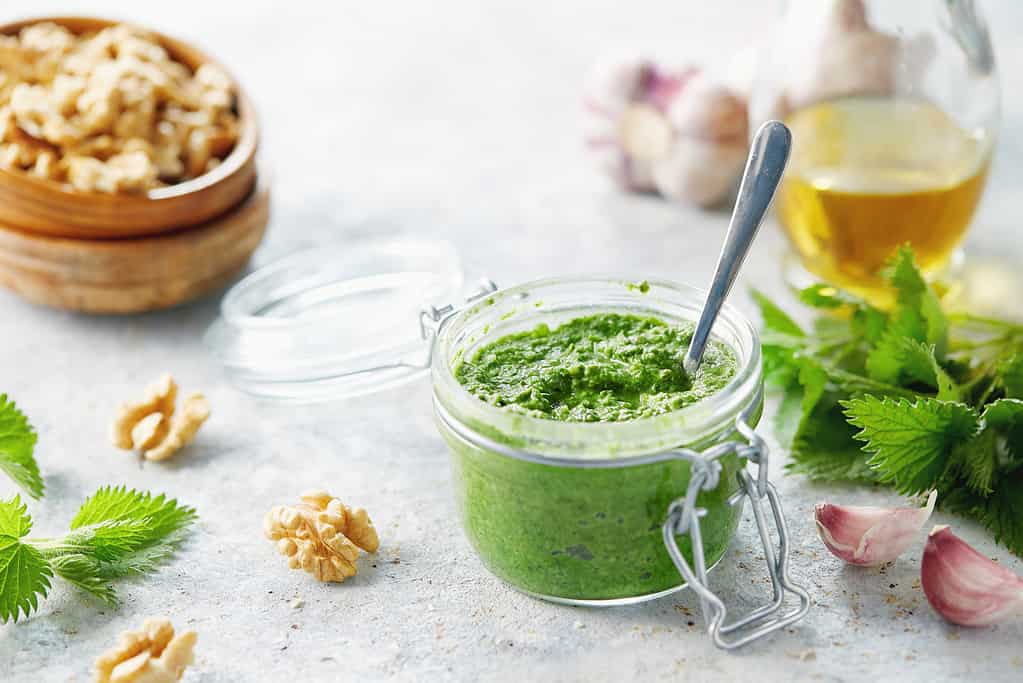
Stinging nettle is very versatile in the kitchen and makes for great pesto, pasta sauce, and herbed butter.
©gojak/iStock via Getty Images
Because stinging nettle is nutritionally dense, you can also use it to fortify bread, pasta, and pastry doughs. This also imparts a beautiful light green color to the end product. Whether you’re interested in the nutritional benefits or not, you can use stinging nettle to replace artificial food coloring in festive dishes and desserts. The extra vitamins and minerals are just icing on the cake!
No matter how you choose to use your fresh stinging nettles, you’ll need to make sure you prepare them properly first. While they fit into innumerable cooked dishes, you can’t eat them raw without quite a bit of discomfort. Further down, we’ll talk about how to quickly and easily disarm the plant’s stinging hairs and render it safe to use in the kitchen.
Good Nutritional Profile
One very good reason you might choose to eat stinging nettle is to take advantage of its wonderful nutritional profile. All parts of the plant are rich in key minerals like potassium, calcium, silica, and iron, as well as vitamins K, A, B2, and B6. Stinging nettles even provide trace elements like selenium, manganese, and copper and are packed full of antioxidants.
According to the USDA, 1 cup of cooked stinging nettles contains:
| Calories | 37 |
| Total Fat | 0.1 g |
| Sodium | 4 mg |
| Potassium | 297 mg |
| Total Carbohydrate | 7g |
| Protein | 2.4 g |
Health Benefits
In addition to its nutritional value, people have historically used stinging nettle to aid in the treatment and prevention of a variety of health problems.
Stinging nettle contains numerous compounds like ursolic acid and quercetin, which show antioxidant and anti-inflammatory properties. Historically, people have used stinging nettle to treat pain associated with inflammatory conditions like arthritis and chronic muscle aches. Modern studies seem to back up these uses. One study, which involved subjects rubbing stinging nettle leaves against a painful joint, showed that the leaves had a greater pain reduction effect than the placebo. Another study, conducted in the UK, drew the same conclusion. Additionally, in 2014, an animal study showed that stinging nettle extract had beneficial effects in rats with post-ovariectomy osteoporosis. In the experiment, the daily administration of the extract restored changes in uterine weight as well as the diameter, density, and calcium content of the animals’ femurs. This seems to support claims regarding the internal use of stinging nettle to support bone health.
Where Does Stinging Nettle Grow in the Wild?
If you’re looking to find stinging nettle, you’re in luck — the plant is quite common throughout much of the world. Originating in Europe, Asia, and North Africa, it has since spread to North America, where it appears across the entirety of Canada and the continental U.S. as well as northern Mexico.
Stinging nettle frequently crops up in moist habitats along streams, creeks, drainage ditches, open woodlands, and mountain hillsides. It is a quick colonizer of disturbed areas like roadsides, and utility rights-of-way, though you probably don’t want to consume plants growing in these areas. Stinging nettle is quite prolific once it has established itself in an area. It spreads quickly using its underground rhizomes and readily self-seeds to form large colonies.
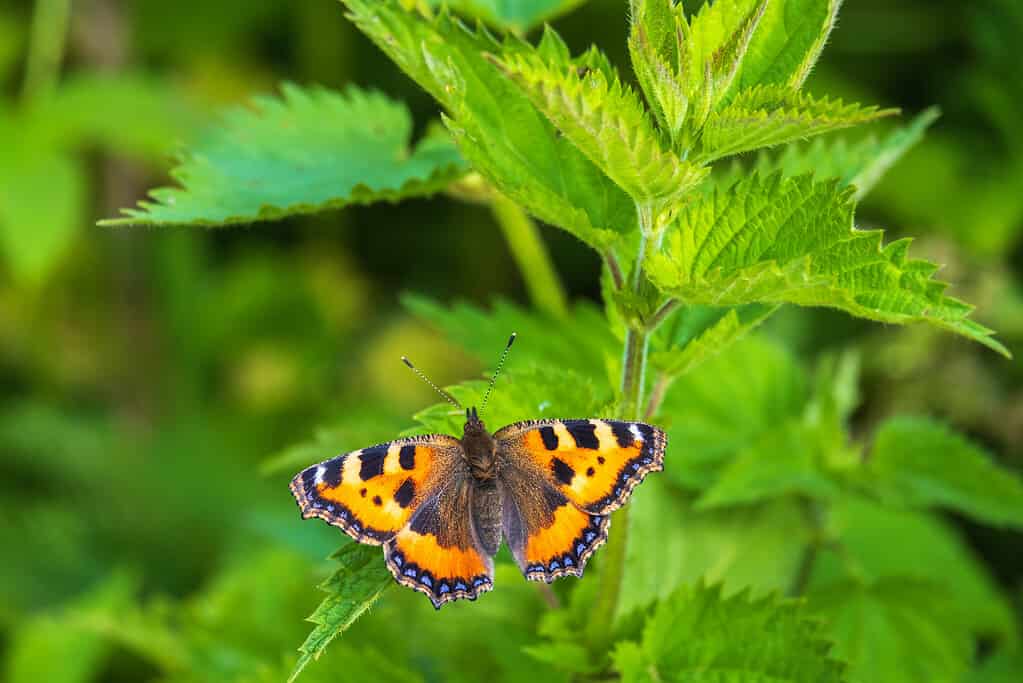
Stinging nettle often grows in large colonies in damp, wooded locations where it plays host to numerous species of
caterpillars
and other insects.
©TT/iStock via Getty Images
How to Identify Stinging Nettle
If you want to eat stinging nettle and aren’t cultivating your own, you need to know how to identify it in the wild. The good news is that it is a fairly easy plant to identify with attention to detail. The herbaceous perennial appears in the spring, reaching heights of 3 to 8 feet by the end of summer. Except for one subspecies, the leaves and stems bear both stinging and non-stinging hairs that give them a rough appearance. While the smaller hairs are soft and do not sting, the larger ones can easily pierce the skin, injecting a chemical cocktail that causes pain and irritation.
The plant’s deeply-veined, opposite leaves are large and oval to egg-shaped, with deeply serrate, or jagged, edges. They grow between 1 and 6 inches in length, emerging in pairs from wiry, square stems. In the late spring or summer, tiny, fairly inconspicuous, light green or brown flowers hang down on long, branching spikes from the bases of the leaves. The flowers never become more colorful, as stinging nettle relies on the wind for pollination and does not need to attract insects. The plant does not branch and grows to its full height on a single stem.
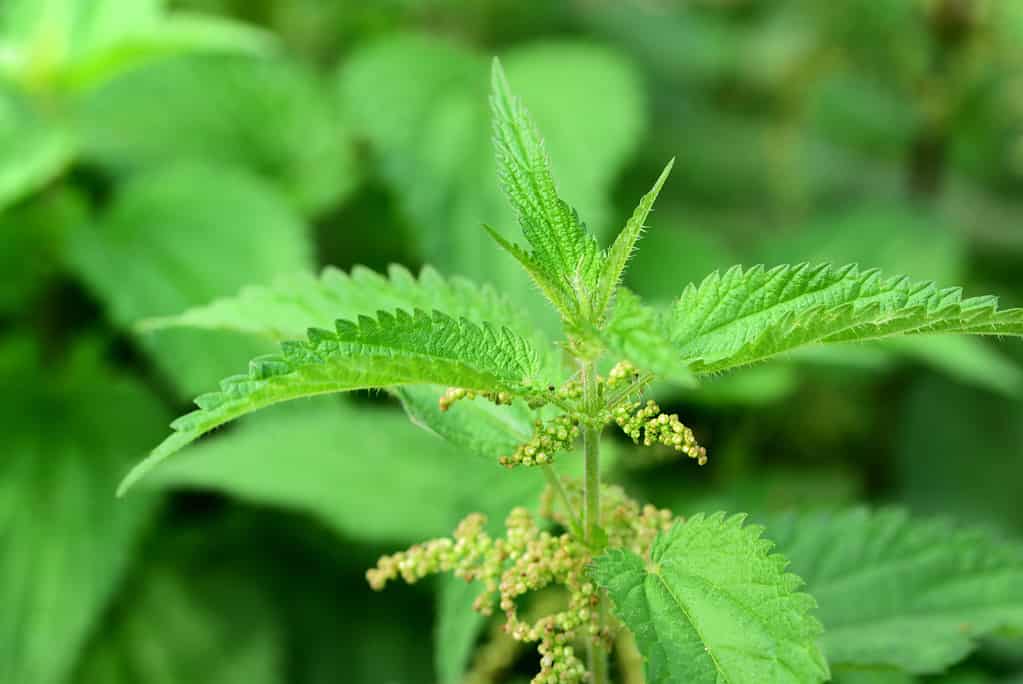
has deep leaf venation, serrate margins, and long clusters of tiny flowers that emerge from the leaf axils in summer.
©Ulrike Leone/iStock via Getty Images
Common Lookalikes
Though stinging nettle is fairly distinctive, it does have some lookalikes. Luckily, none of the closest lookalikes are poisonous.
False Nettle
The false nettle (Boehmeria cylindrica) has leaves that resemble those of stinging nettles, but are generally wider and borne on long, narrow stalks, or petioles. Its stems never have hairs, stinging or otherwise, and though its flower clusters may look similar, they never branch.
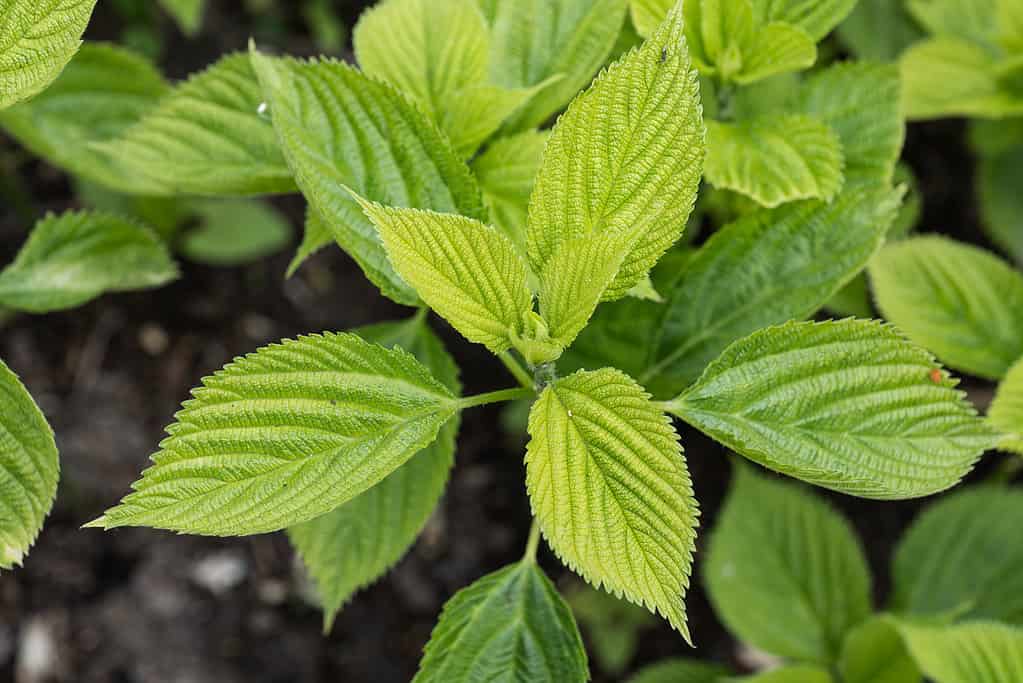
Boehmeria cylindrica, common names: false nettle or bog hemp, is an herb in the family Urticaceae, North America region.
©Artur Bogacki/iStock via Getty Images
Slender Nettle & Dwarf Nettle
Two of its closest lookalikes are its close relatives, also belonging to the genus Urtica. The North American slender nettle (Urtica gracilis) and the dwarf nettle (Urtica urens) closely resemble the Eurasian Urtica dioica and can be difficult to distinguish in some cases. The good news is that all three species are edible, taste similarly, and can be prepared in the same way as the common stinging nettle. The bad news is that they both still sting, and the dwarf nettle packs a much stronger punch.
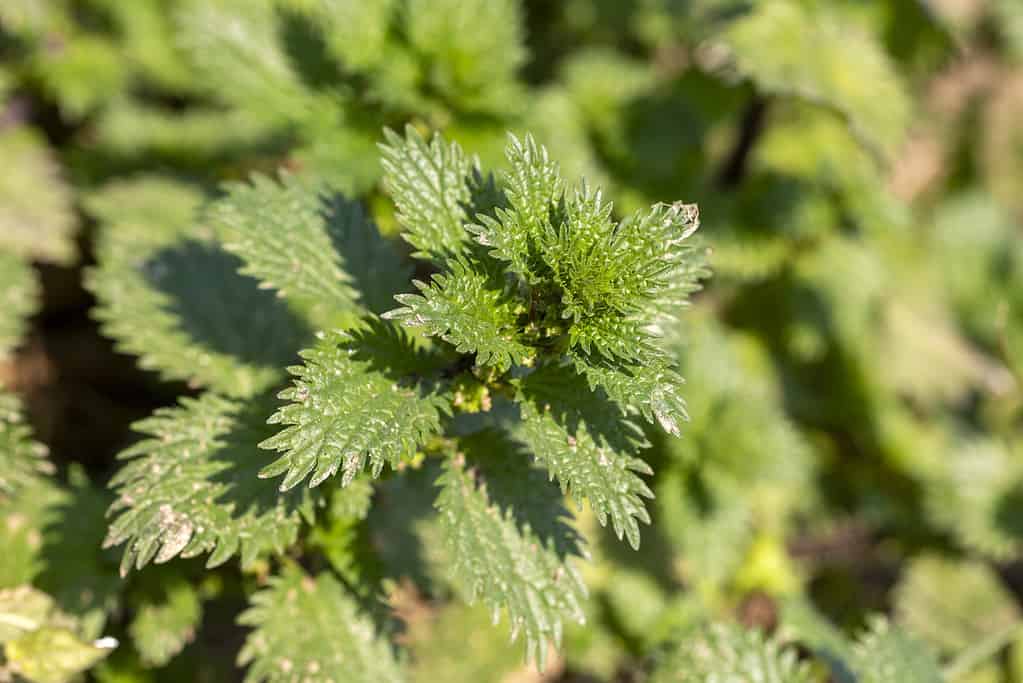
Dwarf stinging nettle,
Urtica urens,has a much more compact growth habit than common stinging nettle, reaching only a few feet in height.
©Esin Deniz/iStock via Getty Images
Wood Nettle
Another species, the wood nettle (Laportea canadensis), resembles all three of the above Urtica species but has much larger leaves that are alternate instead of opposite. Though the male flowers resemble those of U. dioica, the female flowers appear at the top of the plant in large, flat-topped groups that open from the center outward.
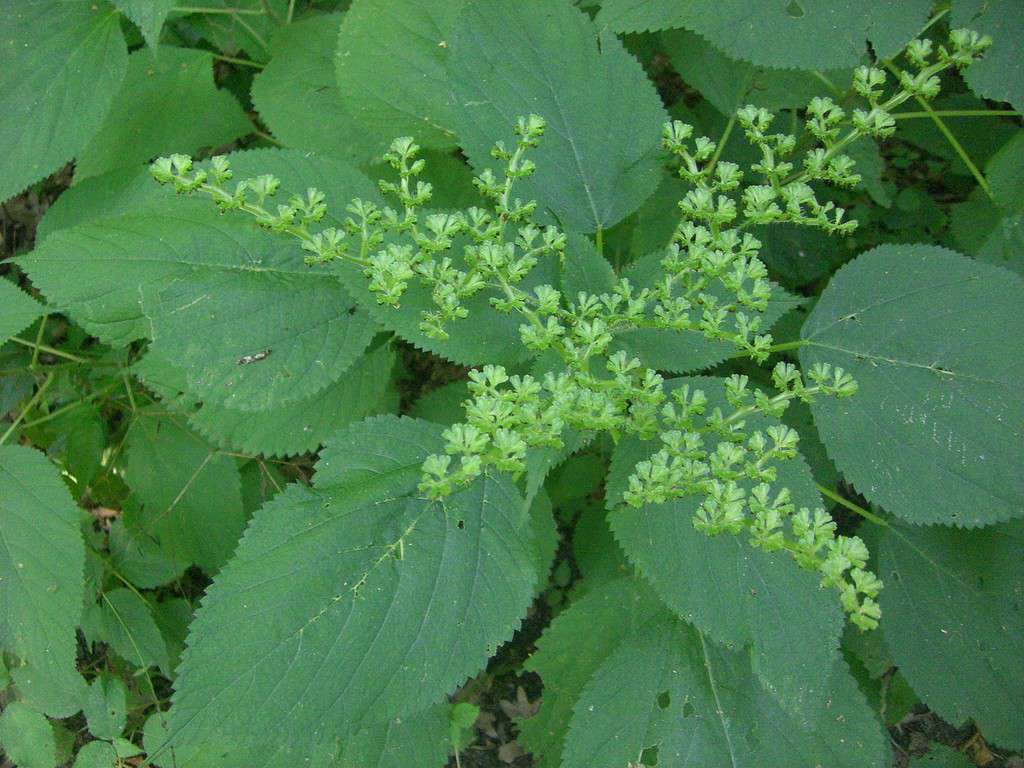
Wood nettle has much larger leaves with shallower serrations and female flowers that rise above the top of the plant.
Canadian Clearweed
Canadian clearweed (Pilea pumila) is often mistaken for stinging nettle as well. It grows in similar moist and shaded habitats, especially those that have been disturbed. While the leaves resemble those of all the species above, they completely lack hairs of any kind. Additionally, the stems of older plants become uniquely translucent, which is where the species derives its common name.

The leaves of
Pilea pumilaare entirely hairless and the stems become translucent with age
©Usama Art and Photography/Shutterstock.com
How and When to Harvest Stinging Nettle
You should exercise caution and protect your skin when harvesting stinging nettle. Though the sharp hairs may occasionally get through, wearing gloves and long-sleeved clothing will minimize the chances of being stung.
Because they are fast-growing green vegetables, you can harvest stinging nettles any time of year, from spring until the plant begins to die back in the fall. Find a plant that has several sets of leaves and, wearing gloves, snip away the first one to three pairs of tender, young leaves. Harvesting this way encourages the plant to become leafier and also ensures that there is plenty left behind for the plant to sustain itself. Many people recommend harvesting stinging nettles before they begin to flower as the leaves develop crystals called cystoliths during flowering. Though many state that the cystoliths can be hard on the kidneys and urinary tract, there is no scientific evidence to support these claims.
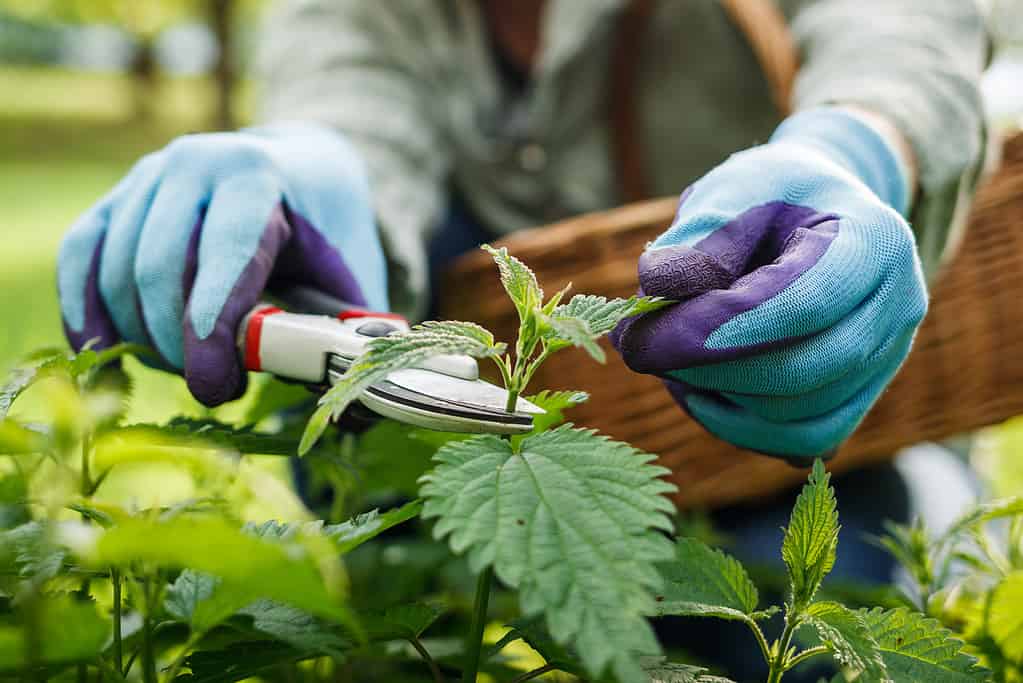
When harvesting nettles, take the top few pairs of young leaves. Older leaves tend to be fibrous and chewy.
©Zbynek Pospisil/iStock via Getty Images
When harvesting wild plants, there are a few best practices to keep in mind. First, you should never harvest more than 5 to 10 percent of any given population. This ensures that there are enough plants left to sustain the population and provide for the other animals that rely on it. In a similar vein, avoid taking the biggest and healthiest plants in the group so that they can pass their strong genetics on to the next generation. Finally, make sure that you don’t harvest more than you need to complete your dish or project. These are living beings, after all, and they’ve spent their lives and resources building themselves up.
Once you’ve harvested what you need, it’s time to process it for use.
How to Prepare and Eat Stinging Nettle
Before you can eat your stinging nettle harvest, you’ll have to take care of the painful stinging hairs. Thankfully, disarming your stinging nettles is easy and there are a couple of ways of doing so. Each method is very simple and involves only a single step.
The first is simply to cook the nettles and add them to your dish. Heating the nettles for long enough breaks down the stinging hairs and neutralizes the painful compounds within them. Simply blanch them, boil them, or sauté them with the rest of your meal and you’ve rendered your stinging nettles safe to eat.
The second method, which allows you to store your harvest for later, is to dry them out. While drying your nettles doesn’t soften the stinging hairs themselves, it does neutralize their stinging chemicals. To dry them out thoroughly, place your stinging nettles in an electric or solar dehydrator or leave them to air dry in an area with good airflow. A common approach is to leave them near an air vent or hang them high on a shady porch or patio. Once the stems snap and the leaves crunch, you can store your harvest for later in an air-tight container.
The photo featured at the top of this post is © IhorM/Shutterstock.com
Thank you for reading! Have some feedback for us? Contact the AZ Animals editorial team.







